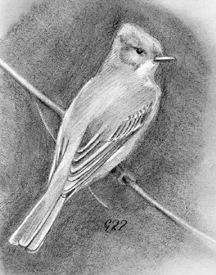
|
Volume XVII, Issue 11 - March 12 - March 18, 2009
|
|
Columns Reviews |
 |
Earth Journal by Gary Pendleton
Spring Follows Snow and Phoebe
If winter comes, can summer be far behind?
With apologies to poet Percy Bysshe Shelly, I would ask if the temperature drops to 11 degrees and a foot of snow falls on the second of March, does that mean it will be spring soon? To answer my own question: Yes, probably, at least I hope so; and as soon as the snow melts I am putting my peas in the ground.

![]() Despite the occasional winter redux, we know that spring is coming. The swelling buds of maple trees create a blush of red against the backdrop of bare trees in the swamp. Here is a phoebe, perched on one of those maple branches. If it is sitting in the sun, it might just sing it’s eponymous, two-note song, fee-bee.
Despite the occasional winter redux, we know that spring is coming. The swelling buds of maple trees create a blush of red against the backdrop of bare trees in the swamp. Here is a phoebe, perched on one of those maple branches. If it is sitting in the sun, it might just sing it’s eponymous, two-note song, fee-bee.
The eastern phoebe is one of the earliest migrating species making up a wave of birds that move northward through the mid-Atlantic from March to May. If the winter is mild, they sometimes linger in damp woods. Even during cold winters, they tend not to travel too far south from the mid-Atlantic.
Phoebes are about seven inches long, handsome but not colorful. They are dark gray on top and pale underneath. Their tails are somewhat long, and their heads are large and blocky. Phoebes typically pump their tales downward as they perch on branches from which they make numerous short flight loops to snag flying insects.
Digress to Tyrants
Phoebes are flycatchers of a particular family. This large group of about 390 species is found exclusively in the New World. The family name evokes a monumental figure in American history, a personage who has received a lot of recent attention. Part of the recent attention includes renewed controversy over Maryland’s provocative state song.
The historical figure is Abe Lincoln; the controversy is due to song lyrics that refer to him as a despot and tyrant. If you have been following the news, you know that there is a push to replace the Civil War-era lyrics of “Maryland My Maryland,” written by a Confederate partisan. The song reflects the passions that deeply divided our country at the time. Our state legislators are, not for the first time, presently considering a bill to change the strikingly colorful lyrics.
So what does this have to do with a bird?
Not much, and I hope you will forgive this trivial digression. But phoebes belong to the family called tyrant flycatchers. They are so-named because they are bold, aggressive and regal in their posture. They might be tyrants, if you are a fly. The connection is thin because only the most die-hard rebel sympathizer would to this day call the great Lincoln a tyrant.
• • • • •
Digression over. Spring is coming. Get out there and keep your eyes open for Sayornis phoebe and other signs.
|
Scientific names: Sayornis phoebe What to look for: A two-toned gray bird, slightly smaller than a robin, that frequently pumps its tail. Where to look: Wooded areas especially near wet areas, five to 10 feet above the ground. Places to visit: Quiet Waters Park, Battle Creek Cypress Swamp. |